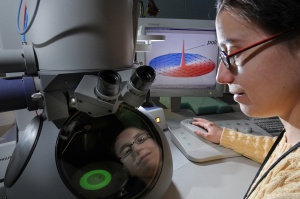Jan 31 2009
At the human scale, the tightly wrapped spinning columns of air in a tornado contain terrifying destructive power that ravages communities. At the nanoscale, however, closely coiled magnetic vortices hold the promise of a new generation of computers.
 Argonne materials scientist Mihaela Tanase observes a small magnetic disk with a transmission electron microscope. Tanase discovered a new method to control the way the atoms in the magnetic disk orient themselves to form "nanoscale vortices," which are illustrated on the computer screen.
Argonne materials scientist Mihaela Tanase observes a small magnetic disk with a transmission electron microscope. Tanase discovered a new method to control the way the atoms in the magnetic disk orient themselves to form "nanoscale vortices," which are illustrated on the computer screen.
Researchers at the U.S. Department of Energy's Argonne National Laboratory have discovered a new way to control the rotation - or chirality - of these infinitesimal "magnetic tornadoes."
A vortex forms spontaneously — one vortex per disk — in a small magnetic disk when the disk's diameter falls below a certain limit. Although the vortex does not whirl about like a meteorological tornado, the atoms in the material do orient themselves so that their magnetic states, or "moments," point either clockwise or counterclockwise around the disk's surface. At the center of the disk, the density of this rotation causes the polarity of the vortex core to point either up out of the disk or down like a tornado's funnel.
Conventional computer memories store data in "bits" that consist of two magnetic elements that record data in binary form. When these elements are magnetized in the same direction, the computer reads the bit as a "0"; when magnetized in opposite directions, the bit represents a "1".
Because the vortices that form on the disks contain two independently controllable and accessible magnetic parameters, they could form the basis for quaternary bits that would contain data written as a 0, 1, 2, or 3. "This technology could change the way we look at how to store data electronically," said Argonne materials scientist Mihaela Tanase.
While prior research had shown the way to create the "tornadoes" and control their polarity, scientists had until recently not found an effective way to prevent the chirality from switching randomly between its alternate states. "The hardest part is finding out how to reverse the chirality in a reproducible way,” Tanase said.
Previous studies that stabilized the vortices' chirality relied on asymmetries in the shape of the disk or in the magnetic fields that researchers applied to it. However, asymmetries in the shape of the disk and the applied magnetic fields can cause the accidental switching of neighboring bits.
Tanase and senior materials scientist Amanda Petford-Long tried to create a reliable way of controlling the vortices' chiralities by annealing the magnetic layer in the disk to an antiferromagnetic one, which allowed them to control the magnetic orientation of the atoms in the disk.
By bringing together this interaction, called exchange bias, and the vortex field, researchers would no longer have to rely on asymmetries to manipulate the chirality of the vortices. In the future, this could enable the writing and reading of digital information with greater sensitivity, reliability and efficiency, Tanase said. A paper based on this research appeared in the January 27 issue of Physical Review B. An abstract can be found online at http://link.aps.org/abstract/PRB/v79/e014436.
This research is a collaboration among Argonne, Seagate Technology and Universidad Autònoma de Barcelona. It was funded by the Basic Energy Sciences (BES) program in the U.S. Department of Energy's Office of Science. The BES mission is to foster and support fundamental research to expand the scientific foundations for new and improved energy technologies and for understanding and mitigating the environmental impacts of energy use. The BES portfolio supports work in the natural sciences, emphasizing fundamental research in materials sciences, chemistry, geosciences and aspects of biosciences.
Tanase and Petford-Long prepared the sample at Argonne's Center for Nanoscale Materials and characterized it at Argonne's Electron Microscopy Center.